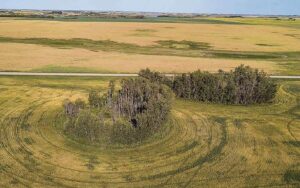Biodiversity from non-crop areas can boost beneficials, possibly yield
Key result:
Non-crop areas within or near to fields can serve as a source and a destination for beneficial insects at different times of the season. A correlational study of 60 million seeded acres of yield data obtained from Agricultural Financial Services Corporation (AFSC) showed that counties in Alberta where fields tend to contain more non-crop areas also have slightly higher canola yields.

The objectives were to survey 150 sites in and near cultivated cropland for beneficial insect diversity and abundance. Paul Galpern and his research team would then use farmer yield data, remote sensing, Agriculture and Agri-Food Canada (AAFC) crop inventory data, and in-person assessments to determine the amount of natural and semi-natural areas in and around annual cropland. With this information, the researchers could determine suitability of variously diverse croplands for beneficial insect habitat, and determine if these spaces contribute to or detract from crop yield.
Galpern and team identified 375 species of wild/native bees in or near fields, many of which are very rare. Fifteen species were at over half the sites, indicating a core group of canola-friendly bees. They also found dozens of rare species of spider in and near crops, and identified 57 species of ground beetle in and near cropland. The conclusion is that non-crop areas within or near to fields are likely to serve as a source as well as a destination for beneficial arthropods at different times of the season. Study locations that had smaller patches of non-crop area that were more evenly distributed had higher abundances of many bee species.
Project title, Principal investigator:
“Surveillance networks for beneficial insects: Can natural habitats serve as insect reservoirs, and do they contribute to canola yield?,”
Paul Galpern, University of Calgary
Funding:
SaskCanola, Alberta Canola, Manitoba Canola Growers
As for the yield benefit, a correlational study of 60 million seeded acres of yield data in Alberta obtained from Agricultural Financial Services Corporation (AFSC) showed that counties in Alberta where fields tend to contain more non-crop areas also have slightly higher canola yields. One reason could be that non-crop areas often serve as hotspots for beneficial arthropods that spill over into canola fields, increasing the visitations
to canola flowers. This evidence is in line with global literature that proximity to natural and semi natural spaces has a positive effect on the yield potential of cropland, at a landscape scale.
Phase II of this project is funded and underway. Phase II will take the landscape yield implication to a field-scale impact. Research will focus on sites across central and southern Alberta to measure yield and quality parameters of crop grown in proximity to these spaces.





